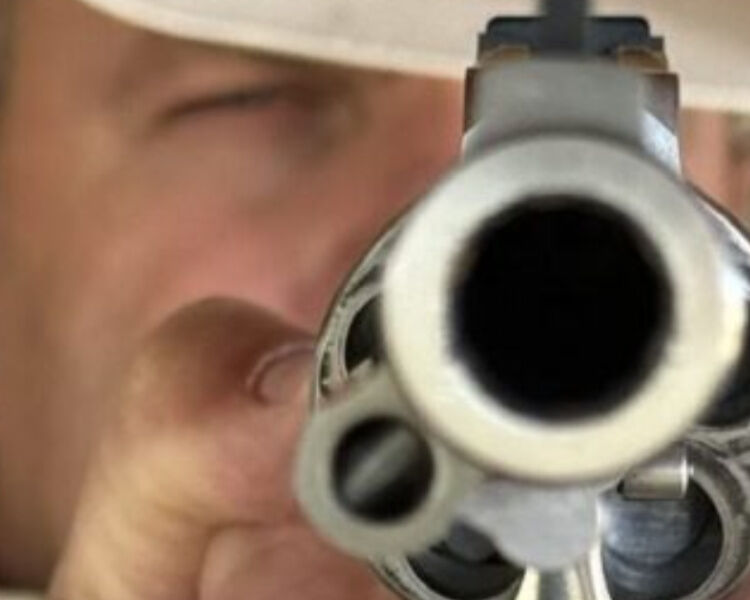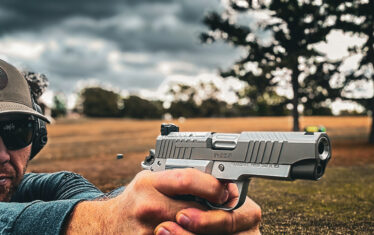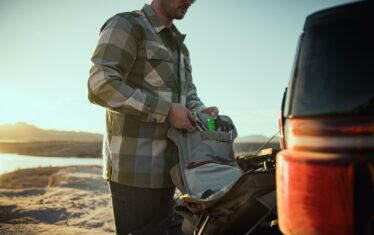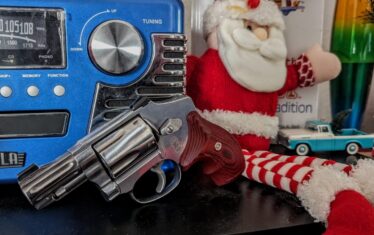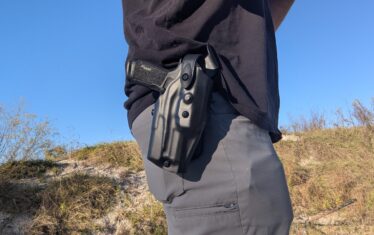Handgun Hunters today have a ton of excellent calibers for hunting everything from prairie dogs to bull elephants. We have hunting handguns chambered in classic calibers like the classic 44 Remington Magnum and 45 Colt, rifle cartridges, and newer rounds like the 350 Legend, 360 Buckhammer, and the popular 6.5 Creedmoor.
Available platforms for the handgun hunter range from revolvers to autoloaders to CVA Scout V2 Pistols, Thompson Center (T/C) Contenders, Remington XP-100s, and newer models like the Savage 110 PCS and Nosler’s Model 48 Independence. This is by no means a complete list of hunting handguns. Although some models are no longer in production, they can easily be found on the used gun market. By the way, the latest exciting news coming from T/C is that the Contender will soon return.
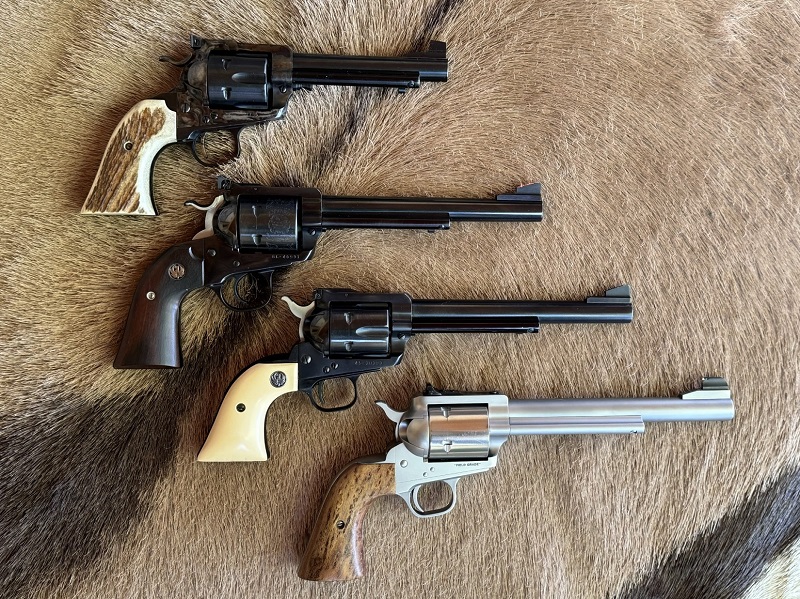
In this article, we will focus on big bore revolver calibers available for hunters, specifically standard cartridges produced by ammunition manufacturers. Perhaps we can cover some of the wildcats and not-so-well-knowns further down the road, as there are several good ones out there.
Big Bore Cartridges for Revolvers
To give a general idea of the power, and thus recoil generated by these cartridges, the Relative Recoil Factor (RRF) is included (when possible) from the good book, “Ammo & Ballistics Fifth Edition” by Bob Forker.
Forker explains that the RRF “is based on the muzzle momentum of the bullet and the expelled powder gas for a typical loading.” As an indicator to compare RRFs to these big bore wheel guns, the number assigned to the 38 Special is 0.53. As you will see, we’re talking about full-size five and six-shot revolvers with substantially more power and recoil than the 38 Special.
For starters, just what is the definition of a big-bore handgun?
Since I’m the one writing this, we’ll have to go with my classifications for today. I originally started out with the 44 Magnum as my beginner, thinking of starting with the .429 diameter bullet cartridge and going up. Then I remembered my beloved 41 Maggie and just couldn’t stand leaving it out of the big bore category. Some might even say it’s really a medium bore, a step between the 357 and 44 Magnums, and that’s fine and at least partly correct to my way of thinking. But they’ll have to write their own article!
What about the 357 Magnum? It’s the first “magnum” handgun cartridge. Some say it’s marginal for deer while others will debunk that suggestion with a stack of photographic evidence, a heaping platter of chicken fried deer steak, and den walls adorned with shoulder mounts, antlers, and a variety of other trophies taken with the 357.
Then there is the 10mm, a capable cartridge that has been rediscovered in recent years. For today, we’re starting with the 41 Magnum and working our way up. Space will not allow a complete listing of all available big-bore revolver rounds, but we’ll take a brief look at some of the most popular.
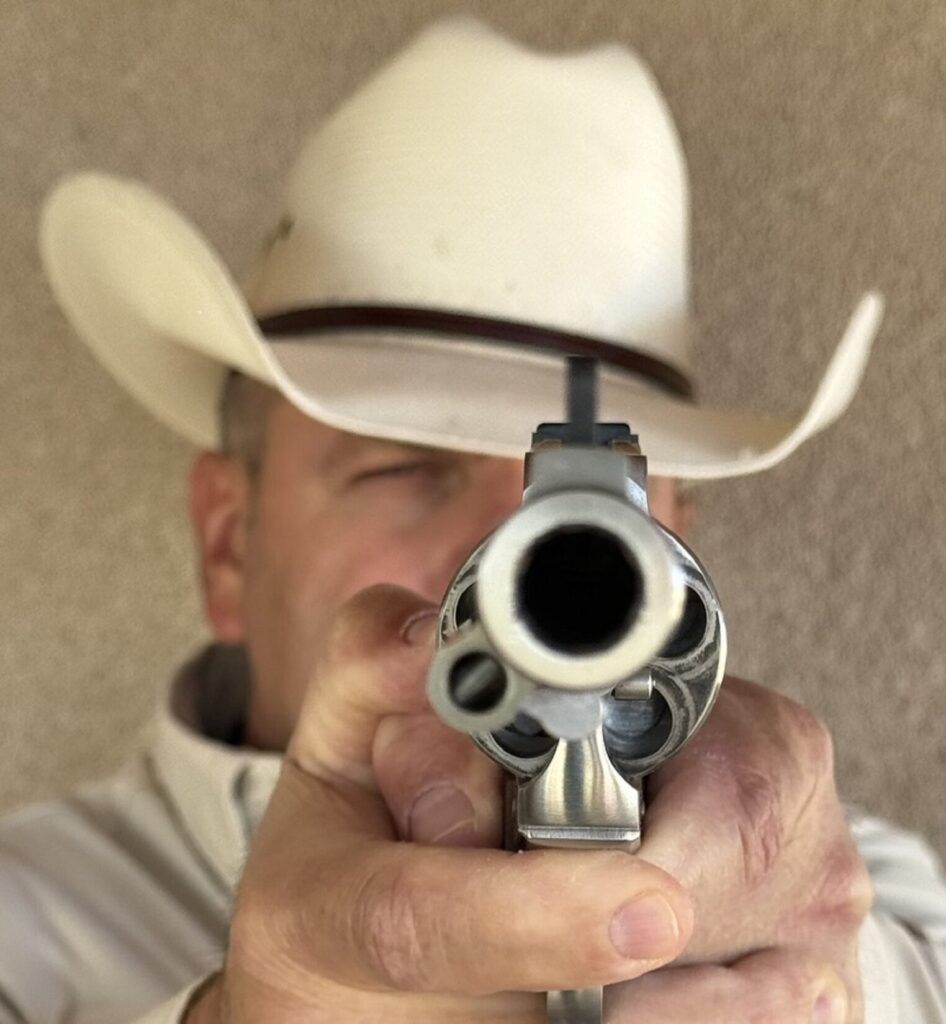
41 Remington Magnum (RRF=1.23)
Occasionally, there’s some debate as to whether the 41 Magnum is as good as the 44 Magnum. While these candid discussions usually provide lively entertainment and offer writers plenty of article content and a higher word count, I usually pay little attention to either side as an absolute answer to the question. It’s similar to the old 30-06 vs 270 debate.
Fact is, we are lucky to have a multitude of good cartridges to choose from. Add in a variety of good commercial ammunition with today’s improved bullet technology, and then factor in the raft of excellent bullets and powders available to the hand loader, and the big-bore handgun hunting options are unlimited.

As for the 41 Magnum, it’s a heck of a good round with bullet options from 170 to 250 grains. I’ve used it on whitetail deer with good effect and would not hesitate to take it after larger animals. And, for those who want to tame the beast a bit, 41 Special ammunition and brass are also available.
44 Remington Magnum (RRF=1.45)
The 44 Magnum might be considered King of the Big Bore Handguns due to simple facts, its longevity, nostalgia, and a little bit of Hollywood.
For the ardent handgunner, it’s darn near impossible to think of the 44 Magnum and not think of Elmer Keith. And for many of us, that’s quite enough to cling to this classic cartridge that is simply one of the best. Bullet weights run from 135 to 320 grains. There ain’t much you can’t do with a good 44 Magnum!
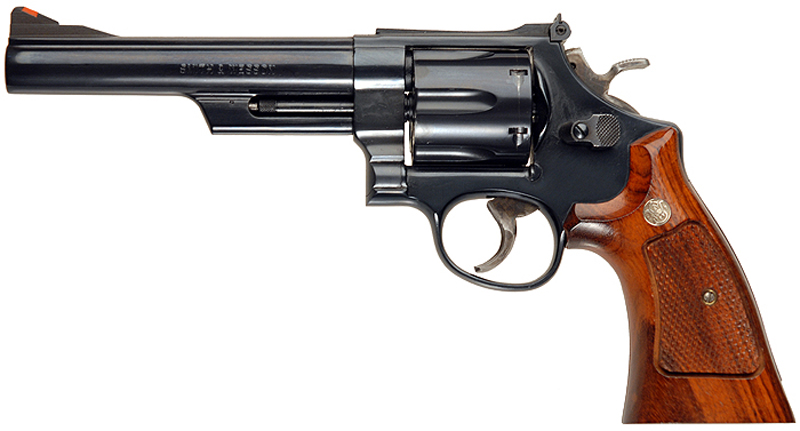
Like the 41 Special, the 44 Smith & Wesson Special (RRF= 0.81) cartridge is an added bonus of the magnum guns. With the proper load, the 44 Special isn’t a cream puff and it can easily be used as a hunting round. Plenty of game have been taken with it.
To tell you the truth, I’ve killed more deer with a 44 Magnum revolver using warm 44 Special-velocity loads (my handloads in magnum cases) than I have with hot-loaded magnums. So, let’s give the 44 Special a mention here in the big bore department because it definitely will work.
45 Colt (RRF=0.90)
In the appropriate revolver, the 45 Colt is a very versatile cartridge. While most shooters will find the mildest Cowboy Action-velocity loads very pleasant to send down range for practice or small game hunting, the option of using the same gun with heavy loads takes it to a whole other level of usefulness. The novice needs to consult knowledgeable sources if “appropriate revolver” is not clear here, as one can get into serious trouble putting hot loads in some revolvers chambered in 45 Colt.
Good guns like Ruger’s Blackhawk and Redhawk, Freedom Arms revolvers, and Magnum Research BFRs can handle most any sensible loads. Bullet options range from 145 grains to 335 and I’ll suggest the RRF is a bit higher, in the 44 Magnum range, with the heavy loads.
Like the 44 Magnum, there isn’t much one can’t hunt with the right revolver in 45 Colt. If I could only have one revolver, it would be chambered in this classic cartridge.
454 Casull (RRF=2.20)
Most will probably describe recoil in the 454 Casull as “snappy” and I’d agree they are correct in that assessment. It is definitely a gun to work yourself up to and it might not be a cartridge for everyone. It can be mastered with concentration and a little determination.
Like many of these good cartridges, the right load with the right bullet can take even the largest animals on the planet.
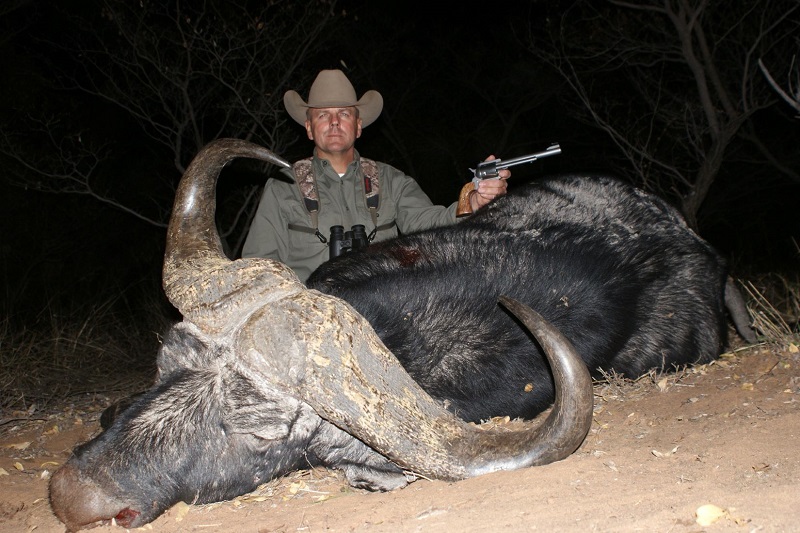
My Freedom Arms Model 83, a very accurate revolver, loaded with Buffalo Bore Ammunition’s Heavy 360-grain hard cast load has taken a cape buffalo bull and a huge bull giraffe. To date, they are the biggest animals I’ve had the pleasure of hunting.
460 S&W (RRF=2.46)
I have a photo of my wife, weighing in at about 110 pounds, blasting rocks with a big, Smith & Wesson X-Frame in 460 S&W right after the gun and cartridge came out around 2005 or so. In an un-ported gun, I’m sure the 460 kicks like a mule, but in that hefty revolver with a brake, it’s not bad at all.
The 460 is a 45 caliber, using the same bullets as the 45 Colt and 454 Casull. Its long case of 1.79 inches allows for more powder capacity and in the stout guns it’s chambered in this means it’s a fast, flat-shooting cartridge, with some loads clocking in at 2000 feet per second.
With the appropriate optic and proper sight-in a practiced hunter with a steady rest has the potential of taking an animal at 200 yards with this cartridge in a handgun. Bullet weights run from 200-395 grains.

475 Linebaugh (RRF=2.30)
The 475 Linebaugh is very powerful and another one that needs to be worked up to in order to be shot accurately and with confidence. Bullet weights range from 265 to 440 grains.
480 Ruger (RRF=1.95)
The 480 Ruger sounds interesting to me, as the cartridge has bullet weights available from 275 to 400 grains and the RRF under 2, so it might be a good candidate for someone dabbling with the idea of getting a big boomer, but not quite sure how much recoil they care to tolerate. I intend to investigate this round further.
45-70 Government (RRF=2.43)
A couple of years ago my friend and fellow outdoor writer, Kristen Alberts, (@thewildernesswoman), killed a good cape buffalo bull with an anvil-tough, Magnum Research BFR revolver in 45-70 Government. One doesn’t normally associate that cartridge in a handgun but it’s not a new thing and it is obviously quite effective.
I currently have one handgun chambered in the 151-year-old cartridge, a Bond Arms Cyclops derringer! Bullets run from 300 to 460 grains in weight.
50 Action Express (RRF=2.05)
This thumper is synonymous with the big Desert Eagle autoloader pistols but is chambered in select revolvers as well. Bullet weights range from 300 to 380 grains.
500 S&W Special (RRF=2.01)
The 500 Special is akin to the 38 Special to the 357 Magnum, 44 Special to 44 Magnum and so on, meaning it’s the shortened case version of the hotter round. Unlike the 38 and 44 Specials who came before their magnum brothers, the 500 Special came a couple of years after the magnum round was released.
Although it has less power than the 500 S&W Magnum, that is a relative term. It’s still a potent cartridge.
500 JRH (aka 500 S&W Short)
This round is another good option for heavy .500-inch bullets at moderate (975 fps) to warmer (1325-1500 fps) velocities.
500 Linebaugh
Firing the 500 Linebaugh in a custom single-action revolver last summer at The Shootists Holiday hooked me on this big round. Folks feel and perceive recoil differently, at least to some extent.
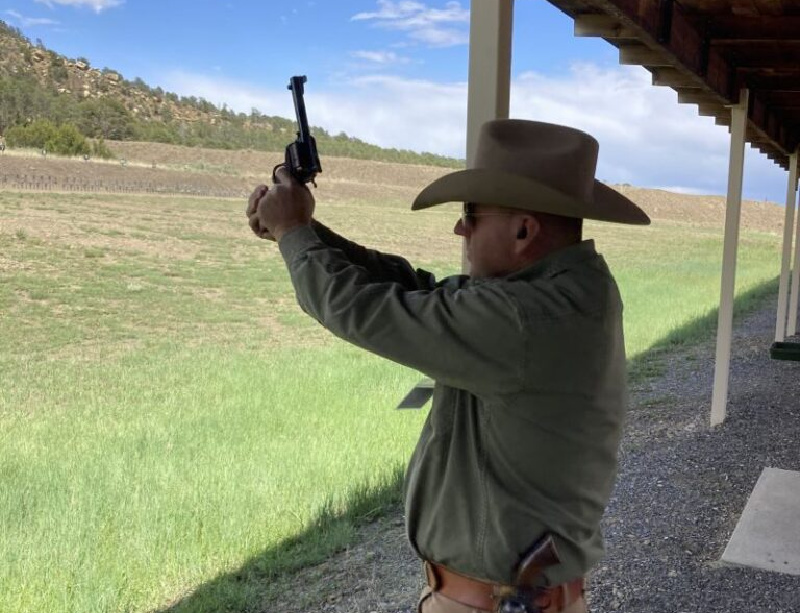
To me, the Linebaugh is more of a heavy push vs a snappy up-and-back motion of say, the 454 Casull. Of course, that has a lot to do with the particular load being fired.
Either way, the idea of pushing heavy bullets of 435 to 525 grains at 950 to 1,100 fps is quite intriguing. So much so that Ronnie Wells at RW Grip Frames (rwgripframes.com) is almost done with my single-action revolver chambered for this renowned cartridge. It will be headed off to South Africa with me as soon as possible to hunt cape buffalo.
500 S&W Magnum (RRF=2.95)
The biggest of the commercial bigguns will most certainly get it done, but it comes with a consequence — recoil.
To put the 500 S&W’s RRF of 2.95 into perspective, let’s compare it to a big rifle cartridge many will be at least vaguely familiar with, the 300 Remington Ultra Magnum. It has an RRF of 2.64. The old trusty 300 Winchester Magnum has an RRF of 2.39.
If you are shooting a 500 Magnum to its full potential with any frequency you will likely want it to be ported in one way or another. With any handgun that generates recoil, proper grip design is key. Bullet weights range from 275 to a whopping 500 grains.
While it does kick like hell in a handgun, the 500 S&W is an accurate round.
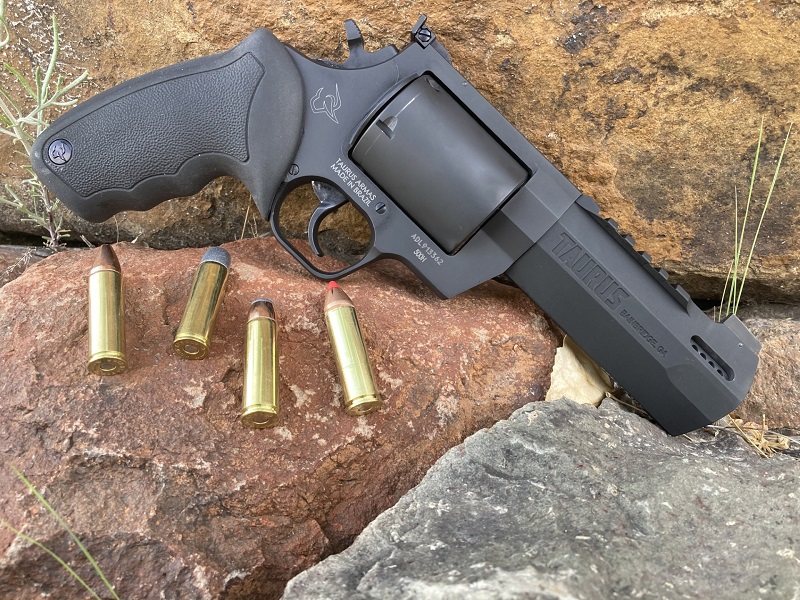
Big Bore Handgun Hunting
Matching up the size of game hunted with these fine big-bore handgun cartridges — with proper bullets propelled by a sufficient amount of powder — is a great step towards being a successful handgun hunter.
Add in a little patience, lots of practice, and a smidgen of luck, and you’ll soon have meat for the table, trophies for the wall, and the added satisfaction of doing it all with a big bore revolver!





